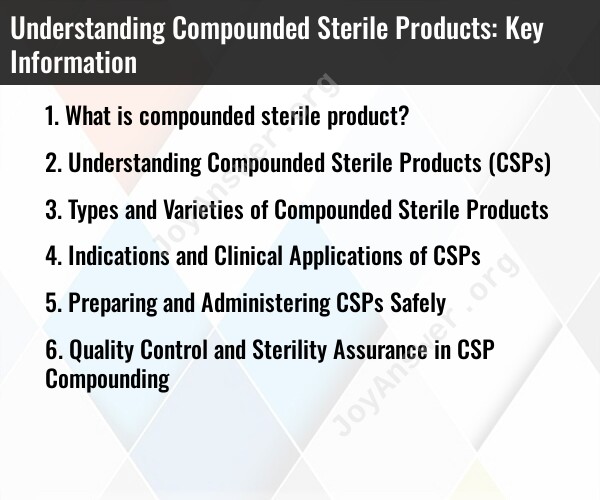What is compounded sterile product?
A compounded sterile product (CSP) is a medication that is prepared by a pharmacist or a licensed healthcare professional in a sterile environment to meet the specific needs of a patient when commercially available medications do not meet those needs. These products are administered to patients in a sterile state, typically via injection or infusion, and they must be free from contaminants and prepared under strict aseptic conditions to ensure patient safety.
Here are some key points to understand about compounded sterile products:
Sterile Conditions: Compounded sterile products must be prepared in a controlled environment that is highly sanitized and free from microorganisms, such as bacteria and fungi. This is crucial to prevent infections and other complications when the product is administered to patients.
Customized Medications: Compounded sterile products are created when commercially available medications are not suitable for a patient's specific needs. For example, they may be necessary for patients with allergies to certain ingredients in standard medications, those who require a different dosage form, or patients with unique medical conditions.
Common CSPs: Common examples of compounded sterile products include intravenous (IV) medications, intrathecal medications (administered into the spinal fluid), and ophthalmic preparations (eye drops or ointments). These are often used in hospitals, clinics, and other healthcare settings.
Regulations: The preparation of compounded sterile products is subject to strict regulations to ensure safety. In the United States, for instance, the U.S. Pharmacopeia (USP) sets standards and guidelines for the preparation and testing of CSPs. Additionally, the FDA has oversight in regulating these products.
Quality Control: Compounded sterile products must undergo quality control measures, such as testing for sterility, potency, and endotoxin levels, to ensure they meet required standards.
Risk of Contamination: Preparing sterile products carries a risk of contamination, which can be harmful or even fatal to patients. As a result, healthcare professionals who compound sterile products follow stringent procedures, including the use of sterile equipment and environments, and may undergo training and certification.
Patient-Specific: These products are typically prepared on a patient-specific basis, meaning they are tailored to an individual patient's needs. This helps ensure that the medication is appropriate for the patient's unique medical condition and circumstances.
Compounding Pharmacies: Compounded sterile products are often prepared in specialized compounding pharmacies or sterile compounding units within healthcare facilities. These facilities are equipped to handle the complexities of sterile product preparation.
It's essential for healthcare professionals to follow strict protocols when compounding sterile products to prevent contamination and ensure patient safety. Regulatory agencies, professional organizations, and guidelines play a crucial role in setting and enforcing standards for CSP preparation.
Understanding Compounded Sterile Products (CSPs)
Compounded sterile products (CSPs) are sterile preparations that are mixed, prepared, compounded, or altered in any way in a pharmacy or other healthcare setting. CSPs are used to meet the unique needs of patients who cannot use commercially available medications due to dosing requirements, allergies, or rare diseases.
CSPs can be divided into two main categories:
- Small volume parenterals (SVNPs): SVNPs are sterile preparations that are intended for injection or infusion. They include syringes, vials, and bags.
- Non-parenteral CSPs: Non-parenteral CSPs are sterile preparations that are not intended for injection or infusion. They include ophthalmic drops, ointments, and gels.
Types and Varieties of Compounded Sterile Products
There are many different types and varieties of CSPs. Some of the most common CSPs include:
- Injectables: Injectables are CSPs that are intended to be injected into the body. They include antibiotics, pain medications, and chemotherapy drugs.
- Infusion solutions: Infusion solutions are CSPs that are intended to be infused into the body over time. They include total parenteral nutrition (TPN) and intravenous (IV) fluids.
- Ophthalmic preparations: Ophthalmic preparations are CSPs that are intended to be applied to the eye. They include eye drops, ointments, and gels.
- Topical preparations: Topical preparations are CSPs that are intended to be applied to the skin. They include creams, lotions, and ointments.
Indications and Clinical Applications of CSPs
CSPs are used in a wide variety of clinical applications. Some of the most common indications for CSPs include:
- Pain management: CSPs can be used to deliver pain medications to patients who cannot take oral medications.
- Infection treatment: CSPs can be used to deliver antibiotics to patients with infections.
- Cancer treatment: CSPs can be used to deliver chemotherapy drugs to patients with cancer.
- Nutritional support: CSPs can be used to provide nutritional support to patients who cannot eat or drink normally.
Preparing and Administering CSPs Safely
The preparation and administration of CSPs must be done carefully to avoid contamination and infection. CSPs must be prepared in a sterile environment and administered using sterile techniques.
Here are some general tips for preparing and administering CSPs safely:
- Prepare CSPs in a sterile environment. This means using a laminar airflow (LAF) hood or a compounding aseptic containment isolator (CACI).
- Use sterile equipment and supplies. This includes syringes, needles, vials, and bags.
- Follow aseptic technique when preparing and administering CSPs. This includes wearing sterile gloves, gown, and mask.
- Label CSPs clearly. The label should include the name of the medication, the dose, the date of preparation, and the expiration date.
Quality Control and Sterility Assurance in CSP Compounding
Quality control and sterility assurance are essential in CSP compounding. Pharmacists must take steps to ensure that CSPs are safe and effective for patients.
Here are some general tips for quality control and sterility assurance in CSP compounding:
- Use a validated compounding process. This means using a process that has been shown to produce sterile CSPs.
- Perform regular quality control checks. This includes testing CSPs for sterility and potency.
- Maintain a clean and sterile compounding environment. This includes cleaning and disinfecting the compounding area regularly.
Conclusion
CSPs are important medications that can meet the unique needs of patients who cannot use commercially available medications. Pharmacists must take steps to ensure that CSPs are prepared and administered safely.












